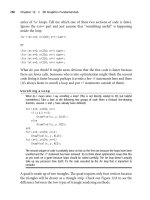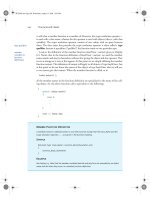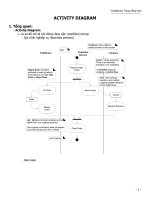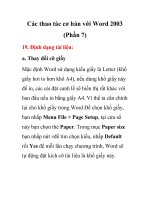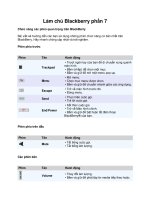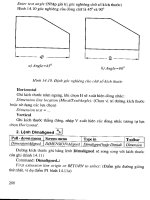xslt cookbook phần 7 pot
Bạn đang xem bản rút gọn của tài liệu. Xem và tải ngay bản đầy đủ của tài liệu tại đây (183.59 KB, 76 trang )
<xsl:apply-templates/>
</table>
</tr>
</table>
</xsl:template>
<xsl:template match="Room">
<tr id="{@id}" style="'background-color:white;'"
onmouseover="on_mouse_over('{@id}')"
onmouseout="on_mouse_out('{@id}')"
onclick="on_mouse_click('{@id}')">
<td><xsl:value-of select="Name"/></td>
<td align="right"><xsl:value-of select="Length"/></td>
<td align="right"><xsl:value-of select="Width"/></td>
<td align="right"><xsl:value-of select="Windows"/></td>
<td><xsl:value-of select="Misc"/></td>
</tr>
</xsl:template>
<xsl:template match="text( )"/>
</xsl:stylesheet>
Figure 9-18. Interactive SVG generated from XML
9.4.3 Discussion
Prior examples focused on generating SVG from XML, while this one focuses on integrating SVG
into a larger application based on other web technologies. This recipe only touches on the
potential of such applications. SVG contains facilities for animation and dynamic content that,
when coupled with XSLT's transformation capabilities, can lead to some impressive results.
Consider the following stylesheet that is based on the graph-drawing primitives of Recipe 9.2, but
allows the user to interact with the graph:
<?xml version="1.0" encoding="UTF-8"?>
<xsl:stylesheet version="1.0"
xmlns:svg="
xmlns:xsl="
xmlns:svgu="
xmlns:test="
exclude-result-prefixes="svgu test">
<xsl:import href="svg-utils.xslt"/>
<xsl:output method="html"/>
<test:data>1.0</test:data>
<test:data>2.0</test:data>
<test:data>3.0</test:data>
<test:data>4.0</test:data>
<test:data>5.0</test:data>
<test:data>13.0</test:data>
<test:data>2.7</test:data>
<test:data>13.9</test:data>
<test:data>22.0</test:data>
<test:data>8.5</test:data>
<xsl:template match="/">
<html>
<head>
<title>Interactive Bar Chart</title>
<object id="AdobeSVG"
classid="clsid:78156a80-c6a1-4bbf-8e6a-3cd390eeb4e2"/>
<xsl:processing-instruction name="import">
<xsl:text>namespace="svg"
implementation="#AdobeSVG"</xsl:text>
</xsl:processing-instruction>
<script><![CDATA[
function on_change (ID,VALUE)
{
//Get the svg doc
var svgDocument =
document.all.item('figure').getSVGDocument( );
//The bars id is prefixed with the context value +
_bar_ + ID
var barName = "interact_bar_" + ID ;
var barObj = svgDocument.getElementById(barName);
if (barObj != null)
{
barObj.setAttribute('y2', VALUE);
}
return true;
}
]]></script>
</head>
<body>
<div align="center">
<svg:svg width="400" height="400" id="figure">
<xsl:call-template name="svgu:bars">
<xsl:with-param name="data"
select="document('')/*/test:data"/>
<xsl:with-param name="width" select=" '300' "/>
<xsl:with-param name="height" select=" '350' "/>
<xsl:with-param name="offsetX" select=" '50' "/>
<xsl:with-param name="offsetY" select=" '25' "/>
<xsl:with-param name="boundingBox" select="1"/>
<xsl:with-param name="max" select="25"/>
<xsl:with-param name="context" select=" 'interact'
"/>
</xsl:call-template>
</svg:svg>
</div>
<table border="1" cellspacing="1" cellpadding="1">
<tbody>
<xsl:for-each select="document('')/*/test:data">
<xsl:variable name="pos" select="position( )"/>
<xsl:variable name="last" select="last( )"/>
<tr>
<td>Bar <xsl:value-of select="$pos"/></td>
<td>
<input type="text">
<xsl:attribute name="value">
<xsl:value-of select="."/>
</xsl:attribute>
<xsl:attribute name="onchange">
<xsl:text>on_change(</xsl:text>
<! Bars oriented upward are rotated so
the ids need
<! to be reversed. See svgu:bars
implementation >
<! for clarification. >
<xsl:value-of select="$last - $pos + 1"/>
<xsl:text>, this.value)</xsl:text>
</xsl:attribute>
</input>
</td>
</tr>
</xsl:for-each>
</tbody>
</table>
</body>
</html>
</xsl:template>
</xsl:stylesheet>
This stylesheet results is a web page that allows you to change data while the height of the bars
responds in kind. This stylesheet also demonstrates the technique for inlining SVG content in
HTML. Unfortunately, it works only with IE 5.5 or higher browsers and assumes that you use the
Adobe SVG plug-in.
[3]
[3]
This, of course, is the configuration used by a large segment of the modern world.
9.4.4 See Also
Didier Martin's XML.com article Integration by Parts: XSLT, XLink and SVG
( contains a more compelling example
involving interaction with a CAD diagram of a complex part.
J. David Eisenberg's SVG Essentials (O'Reilly, 2002) contains detailed information about SVG
animation and scripting.
Chapter 10. Code Generation
Good programmers write good code. Great programmers write programs to generate it.
—Unknown
Automation is the holy grail of software development. In fact, much of the progress in software
development is driven by the notion of code generation from some higher-level specification.
After all, isn't that what assemblers and compilers do? However, in another form of code
generation, the target language is not executable machine code, but a high-level language such as
Java or C++. Why would you want to generate code in this way, and what does XML have to do
with it?
When you write programs, you essentially encode many kinds of knowledge into a very specific
syntax that is optimized for one particular development life-cycle phase. It is difficult to leverage
the work done in coding to other important development tasks because programming languages
are difficult to parse and much of the interesting information is encoded in ad-hoc comments.
Representing application knowledge in XML provides the opportunity for much greater leverage.
From XML specifications, you can generate application code, test programs, documentation, and
possibly even test data. This is not to say that XML gives you this for free. As with all software-
development tasks, a great deal of planning and infrastructure building is required to reap the
benefits.
This chapter is different from most other chapters in this book because most examples are
components of a solution within the context of a particular application. The reason for this
structure is two-fold.
First, it is unlikely that you would encode information in XML to generate code just because XML
is cool. In most cases, a larger problem must be solved in which XML can be further leveraged.
The examples in this section will make more sense if they are presented in the context of a larger
problem.
Second, the particular problem is common in large-scale application development, so readers
might find it interesting in its own right. However, even if this is not the case, the larger problem
will not take away from the application of the concepts to other development tasks.
So what is this large problem?
Imagine a complex client-server application. Complex means that it consists of many types of
server and client processes. These processes communicate via messages using message-oriented
middleware (either pointing to point, publish/subscribe, or both). IBM MQSeries, Microsoft
Message Queuing (MSMQ), BEA Systems Tuxedo, and TIBCO Rendezvous are just a few of the
many products in this space. In this example, the particular middleware product is not particularly
relevant. What is relevant is that all significant work performed by the system is triggered by the
receipt of a message and the subsequent response involving one or more messages.
[1]
The message
may contain XML (SOAP), non-XML text, or binary data. Chapter 12 covers SOAP in the context
of WSDL. This chapter is primarily interested in server-to-server communication in which XML
is used less often.
[1]
Obviously, user input and output is also relevant. However, you can think of I/O in terms of
messages.These user I/O messages are normally sent and received over different channels, though,
not interprocess messages.
What is particularly daunting about such complex systems is that you cannot simply understand
them by viewing the source code of any one particular type of process. You must begin by first
understanding the conversations or inter-process messaging protocols spoken by these processes.
This chapter goes even further and states that, at a first level of approximation, the details of each
individual process are irrelevant. You can simply treat each process as a black box. Then, rather
than understand the hundreds of thousands of lines of code that make up the entire system, you
can start by understanding the smaller set of messages that these processes exchange.
Thus the question becomes, how do you go about understanding the interprocess language of a
complex application? Can you go to a single place to get this information? Sadly, this is often not
the case. I find that you can rarely find an up-to-date and complete specification of an application's
messaging protocols. You can usually find pieces of the puzzle in various shared header files and
other pieces in design documents developed over the system's life cycle, but rarely will you find a
one-stop source for such vital information. And in many cases, the only truly reliable method of
obtaining such information is to reverse-engineer it from the applications' source code, which is
exactly what I claimed you should not have to do!
Okay, so what does this problem have to do with XML, XSLT, and, in particular, code generation?
You can describe the solution to this problem in terms of the need for a documentation that
describes in complete detail an application's interprocess messaging structure. What kind of
document should this be? Maybe the developers should maintain an MS Word document
describing all the messages or, better still, a messaging web site that can be browsed and searched.
Or, maybe (and you should have guessed the answer already) the information should be kept in
XML! Perhaps you should generate the web site from this XML. While you're at it, maybe you
should generate some of the code needed by the applications that processes these messages. This
is, in fact, exactly what you shall do in this chapter. I call the set of XML files an interprocess
message repository. Many recipes in this chapter demonstrate how to generate code using this
repository.
Before moving to the actual recipes, this chapter presents the repository's design in terms of its
schema. It uses W3C XSD Schema for this purpose but only shows an intuitive graphical view for
those unfamiliar with XML schema.
Figure 10-1 was produced using Altova's XML Spy 4.0 (). The icons with
three dots ( ) represent an ordered sequence. The icon that looks like a multiway switch
represents a choice.
Figure 10-1. Graphical representation of XSD schema for repository
Although this schema is sufficient to illustrate interesting code-generation recipes, it is probably
inadequate for an industrial-strength message repository. Additional data might be stored in a
message repository, as shown in the following list:
• Symbolic constants used in array and string sizes, as well as enumerated values
• Information about more complex data representations, such as unions and type-name
aliases (C typedefs)
• Information about message protocols (complex sequences of messages exchanged by sets
of processes to achieve a specific functionality)
• Historical information such as authors, last changed by, change dates, etc.
• Delivery and transport information related to publishers and subscribers or queue names
As sample repository data, imagine a simple client-server application that submits orders and
cancelations for common stock. The repository for such an application might look like this:
<MessageRepository
xmlns:xsi=" xsi:
noNamespaceSchemaLocation="C:\MyProjects\XSLT Cookbook\code
gen\MessageRepository.
xsd">
<DataTypes>
<Primitive>
<Name>Real</Name>
<Size>8</Size>
<Category>real</Category>
</Primitive>
<Primitive>
<Name>Integer</Name>
<Size>4</Size>
<Category>signed integer</Category>
</Primitive>
<Primitive>
<Name>StkSymbol</Name>
<Size>10</Size>
<Category>string</Category>
</Primitive>
<Primitive>
<Name>Message</Name>
<Size>100</Size>
<Category>string</Category>
</Primitive>
<Primitive>
<Name>Shares</Name>
<Size>4</Size>
<Category>signed integer</Category>
</Primitive>
<Enumeration>
<Name>BuyOrSell</Name>
<Enumerators>
<Enumerator>
<Name>BUY</Name>
<Value>0</Value>
</Enumerator>
<Enumerator>
<Name>SELL</Name>
<Value>1</Value>
</Enumerator>
</Enumerators>
</Enumeration>
<Enumeration>
<Name>OrderType</Name>
<Enumerators>
<Enumerator>
<Name>MARKET</Name>
<Value>0</Value>
</Enumerator>
<Enumerator>
<Name>LIMIT</Name>
<Value>1</Value>
</Enumerator>
</Enumerators>
</Enumeration>
<Structure>
<Name>TestData</Name>
<Members>
<Member>
<Name>order</Name>
<DataTypeName>AddStockOrderData</DataTypeName>
</Member>
<Member>
<Name>cancel</Name>
<DataTypeName>CancelStockOrderData</DataTypeName>
</Member>
</Members>
</Structure>
<Structure>
<Name>AddStockOrderData</Name>
<Documentation>A request to add a new
order.</Documentation>
<Members>
<Member>
<Name>symbol</Name>
<DataTypeName>StkSymbol</DataTypeName>
</Member>
<Member>
<Name>quantity</Name>
<DataTypeName>Shares</DataTypeName>
</Member>
<Member>
<Name>side</Name>
<DataTypeName>BuyOrSell</DataTypeName>
</Member>
<Member>
<Name>type</Name>
<DataTypeName>OrderType</DataTypeName>
</Member>
<Member>
<Name>price</Name>
<DataTypeName>Real</DataTypeName>
</Member>
</Members>
</Structure>
<Structure>
<Name>AddStockOrderAckData</Name>
<Documentation>A positive acknowledgment that order
was added successfully.
</Documentation>
<Members>
<Member>
<Name>orderId</Name>
<DataTypeName>Integer</DataTypeName>
</Member>
</Members>
</Structure>
<Structure>
<Name>AddStockOrderNackData</Name>
<Documentation>An negative acknowledgment that order
add was unsuccessful.
</Documentation>
<Members>
<Member>
<Name>reason</Name>
<DataTypeName>Message</DataTypeName>
</Member>
</Members>
</Structure>
<Structure>
<Name>CancelStockOrderData</Name>
<Documentation>A request to cancel all or part of an
order</Documentation>
<Members>
<Member>
<Name>orderId</Name>
<DataTypeName>Integer</DataTypeName>
</Member>
<Member>
<Name>quantity</Name>
<DataTypeName>Shares</DataTypeName>
</Member>
</Members>
</Structure>
<Structure>
<Name>CancelStockOrderAckData</Name>
<Documentation>A positive acknowledgment that order
was canceled successfully.
</Documentation>
<Members>
<Member>
<Name>orderId</Name>
<DataTypeName>Integer</DataTypeName>
</Member>
<Member>
<Name>quantityRemaining</Name>
<DataTypeName>Shares</DataTypeName>
</Member>
</Members>
</Structure>
<Structure>
<Name>CancelStockOrderNackData</Name>
<Documentation>An negative acknowledgment that the
order cancel was
unsuccessful.</Documentation>
<Members>
<Member>
<Name>orderId</Name>
<DataTypeName>Integer</DataTypeName>
</Member>
<Member>
<Name>reason</Name>
<DataTypeName>Message</DataTypeName>
</Member>
</Members>
</Structure>
</DataTypes>
<Messages>
<Message>
<Name>ADD_STOCK_ORDER</Name>
<MsgId>1</MsgId>
<DataTypeName>AddStockOrderData</DataTypeName>
<Senders>
<ProcessRef>StockClient</ProcessRef>
</Senders>
<Receivers>
<ProcessRef>StockServer</ProcessRef>
</Receivers>
</Message>
<Message>
<Name>ADD_STOCK_ORDER_ACK</Name>
<MsgId>2</MsgId>
<DataTypeName>AddStockOrderAckData</DataTypeName>
<Senders>
<ProcessRef>StockServer</ProcessRef>
</Senders>
<Receivers>
<ProcessRef>StockClient</ProcessRef>
</Receivers>
</Message>
<Message>
<Name>ADD_STOCK_ORDER_NACK</Name>
<MsgId>3</MsgId>
<DataTypeName>AddStockOrderNackData</DataTypeName>
<Senders>
<ProcessRef>StockServer</ProcessRef>
</Senders>
<Receivers>
<ProcessRef>StockClient</ProcessRef>
</Receivers>
</Message>
<Message>
<Name>CANCEL_STOCK_ORDER</Name>
<MsgId>4</MsgId>
<DataTypeName>CancelStockOrderData</DataTypeName>
<Senders>
<ProcessRef>StockClient</ProcessRef>
</Senders>
<Receivers>
<ProcessRef>StockServer</ProcessRef>
</Receivers>
</Message>
<Message>
<Name>CANCEL_STOCK_ORDER_ACK</Name>
<MsgId>5</MsgId>
<DataTypeName>CancelStockOrderAckData</DataTypeName>
<Senders>
<ProcessRef>StockServer</ProcessRef>
</Senders>
<Receivers>
<ProcessRef>StockClient</ProcessRef>
</Receivers>
</Message>
<Message>
<Name>CANCEL_STOCK_ORDER_NACK</Name>
<MsgId>6</MsgId>
<DataTypeName>CancelStockOrderNackData</DataTypeName>
<Senders>
<ProcessRef>StockServer</ProcessRef>
</Senders>
<Receivers>
<ProcessRef>StockClient</ProcessRef>
</Receivers>
</Message>
<Message>
<Name>TEST</Name>
<MsgId>7</MsgId>
<DataTypeName>TestData</DataTypeName>
<Senders>
<ProcessRef>StockServer</ProcessRef>
</Senders>
<Receivers>
<ProcessRef>StockClient</ProcessRef>
</Receivers>
</Message>
</Messages>
<Processes>
<Process>
<Name>StockClient</Name>
</Process>
<Process>
<Name>StockServer</Name>
</Process>
</Processes>
</MessageRepository>
This repository describes the messages that are sent between a client (called StockClient)
and a server (called StockServer) as the application performs its various duties. Readers
familiar with WSDL will see a similarity; however, WSDL is specific to web-service
specifications and is most often used in the context of SOAP services, even though the WSDL
specification is technically protocol-neutral ( Note that WSDL is a
W3C note, not a recommendation. The official Web Services Description Working Group
( is working on what will eventually be a W3C-sanctioned
standard.
The last two examples in this chapter are independent of the messaging problem. The first focuses
on generating C++ code from Unified Modeling Language (UML) models exported from a UML
modeling tool via XML Metadata Interchange (XMI). The second discusses using XSLT to
generate XSLT.
Before proceeding with the actual examples, I apologize for using C++ for most of the examples. I
did this only because it is the language with which I am most familiar; it is the language for which
I have actually written generators; and the conceptual framework is transferable to other languages,
even if the literal XSLT is not.
[2]
[2]
I am tempted to add, only half in jest, that C++ is such a horrendously complex language that its
developers are the most motivated to generate rather than code it!
10.1 Generating Constant Definitions
10.1.1 Problem
You want to generate a source file containing all message names as constants equivalent to their
message IDs.
10.1.2 Solution
You can construct a single transformation that uses C++ as the default target but is easily
customized for C, C#, or Java:
<?xml version="1.0" encoding="UTF-8"?>
<xsl:stylesheet version="1.0"
xmlns:xsl="
<xsl:output method="text"/>
<xsl:strip-space elements="*"/>
<! The name of the output source code file. >
<xsl:param name="file" select=" 'MESSAGE_IDS.h' "/>
<! The default behavior is to generate C++ style
constants >
<xsl:variable name="constants-type" select=" 'const int'
"/>
<! The default C++ assigment operator >
<xsl:variable name="assignment" select=" ' = ' "/>
<! The default C++ statement terminator >
<xsl:variable name="terminator" select=" ';' "/>
<! Transform repository into a sequence of message
constant
definitions >
<xsl:template match="MessageRepository">
<xsl:call-template name="constants-start"/>
<xsl:apply-templates select="Messages/Message"/>
<xsl:call-template name="constants-end"/>
</xsl:template>
<! Each meesage becomes a comment and an constant
definition >
<xsl:template match="Message">
<xsl:apply-templates select="." mode="doc" />
<xsl:apply-templates select="." mode="constant" />
</xsl:template>
<! C++ header files start with an inclusion guard >
<xsl:template name="constants-start">
<xsl:variable name="guard"
select="translate($file,'.','_')"/>
<xsl:text>#ifndef </xsl:text>
<xsl:value-of select="$guard"/>
<xsl:text>
</xsl:text>
<xsl:text>#define </xsl:text>
<xsl:value-of select="$guard"/>
<xsl:text>


</xsl:text>
</xsl:template>
<! C++ header files end with the closure of the top
level inclusion
guard >
<xsl:template name="constants-end">
<xsl:variable name="guard"
select="translate($file,'.','_')"/>
<xsl:text>


#endif /* </xsl:text>
<xsl:value-of select="$guard"/>
<xsl:text> */
</xsl:text>
</xsl:template>
<! Each constant definition is preceeded by a cooment
describing the
associated message >
<xsl:template match="Message" mode="doc">
/*
* Purpose: <xsl:call-template name="format-comment">
<xsl:with-param name="text"
select="Documentation"/>
</xsl:call-template>
* Data Format: <xsl:value-of select="DataTypeName"/>
* From: <xsl:apply-templates select="Senders"
mode="doc"/>
* To: <xsl:apply-templates select="Receivers"
mode="doc"/>
*/
</xsl:template>
<! Used in the generation of message documentation.
Lists sender or
receiver processes >
<xsl:template match="Senders|Receivers" mode="doc">
<xsl:for-each select="ProcessRef">
<xsl:value-of select="."/>
<xsl:if test="position( ) != last( )">
<xsl:text>, </xsl:text>
</xsl:if>
</xsl:for-each>
</xsl:template>
<! This utility wraps comments at 40 characters wide >
<xsl:template name="format-comment">
<xsl:param name="text"/>
<xsl:choose>
<xsl:when test="string-length($text)<40">
<xsl:value-of select="$text"/>
</xsl:when>
<xsl:otherwise>
<xsl:value-of select="substring($text,1,39)"/>
<xsl:text>*
</xsl:text>
<xsl:call-template name="format-comment">
<xsl:with-param name="text"
select="substring($text,40)"/>
</xsl:call-template>
</xsl:otherwise>
</xsl:choose>
</xsl:template>
<! Each message name becomes a constant whose value is
the message
id >
<xsl:template match="Message" mode="constant">
<xsl:value-of select="$constants-type"/><xsl:text>
</xsl:text>
<xsl:value-of select="Name"/>
<xsl:value-of select="$assignment"/>
<xsl:value-of select="MsgId"/>
<xsl:value-of select="$terminator"/>
<xsl:text>
</xsl:text>
</xsl:template>
<! Ignore text nodes not explicitly handled by above
templates >
<xsl:template match="text( )"/>
</xsl:stylesheet>
When run against your repository, this transform generates the following code:
#ifndef MESSAGE_IDS_h
#define MESSAGE_IDS_h
/*
* Purpose: Add a new order.
* Data Format: AddStockOrderData
* From: StockClient
* To: StockServer
*/
const int ADD_STOCK_ORDER_ID = 1;
/*
* Purpose: Acknowledge the order has been added.
* Data Format: AddStockOrderAckData
* From: StockServer
* To: StockClient
*/
const int ADD_STOCK_ORDER_ACK_ID = 2;
/*
* Purpose: Error adding the order. Perhaps it violates
* a rule.
* Data Format: AddStockOrderNackData
* From: StockServer
* To: StockClient
*/
const int ADD_STOCK_ORDER_NACK_ID = 3;
//Etc
#endif /* MESSAGE_IDS_h */
10.1.3 Discussion
To make the code-generation transformation customizable for several languages, I use a stylesheet
that is more complex than necessary for any single language. Still, this chapter did not generalize
it completely. For example, the commenting conventions assume the language is in the C ancestry.
The content of the comments also may not suit your particular style or taste. However, as you
create your own code-generation templates, you should apply these customization techniques:
1. Encode language-specific constructs in top-level parameters or variables so they can be
overridden by importing stylesheets or (if you use parameters) by passing in parameter
values when the stylesheet is run.
2. Break the various generated components into separate templates that can be overridden
individually by importing stylesheets.
Having designed the transformation in this way allows C-style #define constants to be
generated with only minor changes:
<?xml version="1.0" encoding="UTF-8"?>
<xsl:stylesheet version="1.0"
xmlns:xsl="
<xsl:import href="msgIds.xslt"/>
<xsl:variable name="constants-type" select=" '#define '
"/>
<xsl:variable name="assignment" select=" ' ' "/>
<xsl:variable name="terminator" select=" '' "/>
</xsl:stylesheet>
Java requires everything to live inside a class, but you can accommodate that too:
<xsl:stylesheet version="1.0"
xmlns:xsl="
<xsl:import href="msgIds.xslt"/>
<xsl:variable name="constants-type" select=" 'public static
final int' "/>
<xsl:template name="constants-start">
<xsl:text>final public class MESSAGE_IDS 
</xsl:text>
<xsl:text>{
</xsl:text>
</xsl:template>
<xsl:template name="constants-end">
<xsl:text>

}
</xsl:text>
</xsl:template>
</xsl:stylesheet>
10.2 Generating Switching Code
10.2.1 Problem
You want to generate the switching code that will route incoming messages to their message
handlers.
10.2.2 Solution
The message repository stores information about which processes receive which messages.
Therefore, given a process name, you can generate a message switch that routes inbound messages
to handlers:
<?xml version="1.0" encoding="UTF-8"?>
<xsl:stylesheet version="1.0"
xmlns:xsl="
<xsl:output method="text"/>
<xsl:param name="process" select=" '*' "/>
<xsl:variable name="message-dir" select=" 'messages' "/>
<xsl:variable name="directory-sep" select=" '/' "/>
<xsl:variable name="include-ext" select=" '.h' "/>
<xsl:template match="MessageRepository">
<! Generate source file preliminaries >
<xsl:call-template name="file-start"/>
<! Generate includes for messages this process recives
>
<xsl:apply-templates select="Messages/
Message[Receivers/
ProcessRef =
$process or
$process = '*']"
mode="includes"/>
<! Generate message switch preliminaries
>
<xsl:call-template name="switch-start"/>
<! Generate switch body >
<xsl:apply-templates select="Messages/
Message[Receivers/
ProcessRef =
$process or
$process = '*']"
mode="switch"/>
<! Generate switch end >
<xsl:call-template name="switch-end"/>
<! Generate file end >
<xsl:call-template name="file-end"/>
</xsl:template>
<! Generate an include for each message >
<xsl:template match="Message" mode="includes">
<xsl:text>#include <</xsl:text>
<xsl:value-of select="$message-dir"/>
<xsl:value-of select="$directory-sep"/>
<xsl:value-of select="Name"/>
<xsl:value-of select="$include-ext"/>
<xsl:text>>
</xsl:text>
</xsl:template>
<! Generate handler case for each message type >
<xsl:template match="Message" mode="switch">
case <xsl:value-of select="Name"/>_ID:
<xsl:call-template name="case-action"/>
</xsl:template>
<! Generate the message handler action >
<xsl:template name="case-action">
return <xsl:value-of
select="Name"/>(*static_cast<const <xsl:value-of
select="DataTypeName"/>*>(msg.getData( ))).process( ) ;
</xsl:template>
<! Do nothing by default. Users will override if
necessary >
<xsl:template name="file-start"/>
<xsl:template name="file-end"/>
<! Generate satrt of switch statement >
<xsl:template name="switch-start">
#include <transport/Message.h>
#include <transport/MESSAGE_IDS.h>
<xsl:text>

</xsl:text>
<xsl:call-template name="process-function"/>
{
switch (msg.getId( ))
{
</xsl:template>
<xsl:template name="switch-end">
return false ;
}
}
</xsl:template>
<! Generate signiture for message processing entry point -
->
<xsl:template name="process-function">
bool processMessage(const Message& msg)
</xsl:template>
</xsl:stylesheet>
When applied to your test repository, this example produces the following switching code:
#include <messages/ADD_STOCK_ORDER.h>
#include <messages/CANCEL_STOCK_ORDER.h>
#include <transport/Message.h>
#include <transport/MESSAGE_IDS.h>
bool processMessage(const Message& msg)
{
switch (msg.getId( ))
{
case ADD_STOCK_ORDER_ID:
return ADD_STOCK_ORDER(*static_cast<const
AddStockOrderData*>(msg.getData( ))).process( ) ;
case CANCEL_STOCK_ORDER_ID:
return CANCEL_STOCK_ORDER(*static_cast<const
CancelStockOrderData*>(msg.getData( ))).process( ) ;
return false ;
}
}
10.2.3 Discussion
Applications that process messages always have some form of message switch. The structure of
these switches can vary somewhat, but they typically must check for some message identifier and
route the message to a handler. The identifier can take the form of an integer (as in your case) or a
string. In some cases, multipart identifiers consist of a message type and subtype. On the
processing side, the handler can take the form of a simple function or an object that is instantiated
to process the message. It is important to make even simple code generators modular so that they
can be resued in more than one context. At a company where I once worked, a group decided to
create a very interesting Perl-based facility that generated C++ code from an XSD schema. It was
of sufficient usefulness that other groups wanted to use it. Unfortunately, the developers thought
only in terms of their particular needs, and their otherwise impressive solution was not reusable.
Writing even basic code generators is a formidable task, and you should try to make them as
general as is practical so others will not have to relive your pain.
The particular solution shown provides several hooks for customizing what appears at the start of
the generated file, the start of the switching code, the end of the switching code, and the end of the
file. This flexibility allows Recipe 10.5 to reuse this generator. Still, it could use further
improvement. For example, this generator assumes that a C switch statement performs message
switching. However, some applications may use an if-else style switch, especially if the message
IDs are strings. Others may use a table lookup from the message ID to a function pointer.
Can a single generator be made general enough to handle all these possibilities? Maybe, but the
result will probably be extremely complex. A better approach would create generation
components that could be reused in more complex generation scenarios. Here is what a generic C-
switch statement generator might look like:
<?xml version="1.0" encoding="UTF-8"?>
<!DOCTYPE xslt [
<! Used to control code intenting >
<!ENTITY INDENT " ">
<!ENTITY INDENT2 "&INDENT;&INDENT;">
]>
<xsl:stylesheet version="1.0"
xmlns:xsl="
<xsl:template name="gen-C-Switch">
<xsl:param name="variable"/>
<xsl:param name="cases" select="/ "/>
<xsl:param name="actions" select="/ "/>
<xsl:param name="default"/>
<xsl:param name="baseIndent" select="'&INDENT;'"/>
<xsl:param name="genBreak" select="true( )"/>
<xsl:value-of select="$baseIndent"/>
<xsl:text>switch (</xsl:text>
<xsl:value-of select="$variable"/>
<xsl:text>)
</xsl:text>
<xsl:value-of select="$baseIndent"/>
<xsl:text>{
</xsl:text>
<xsl:for-each select="$cases">
<xsl:variable name="pos" select="position( )"/>
<xsl:value-of select="$baseIndent"/>
<xsl:text>&INDENT;case </xsl:text>
<xsl:value-of select="."/>
<xsl:text>:
</xsl:text>
<xsl:call-template name="gen-C-Switch-caseBody">
<xsl:with-param name="case" select="."/>
<xsl:with-param name="action"
select="$actions[$pos]"/>
<xsl:with-param name="baseIndent"
select="concat('&INDENT2;',$baseIndent)"/>
</xsl:call-template>
<xsl:if test="$genBreak">
<xsl:value-of select="$baseIndent"/>
<xsl:text>&INDENT2;break;</xsl:text>
</xsl:if>
<xsl:text>
</xsl:text>
</xsl:for-each>
<xsl:if test="$default">
<xsl:value-of select="$baseIndent"/>
<xsl:text>&INDENT;default:</xsl:text>
<xsl:text>:
</xsl:text>
<xsl:call-template name="gen-C-Switch-default-
caseBody">
<xsl:with-param name="action" select="$default"/>
<xsl:with-param name="baseIndent"
select="concat('&INDENT2;',$baseIndent)"/>
</xsl:call-template>
<xsl:text>
</xsl:text>
</xsl:if>
<xsl:value-of select="$baseIndent"/>
<xsl:text>}
</xsl:text>
</xsl:template>
<! This generates a null statement by default. >
<! Override to generate code for the case >
<xsl:template name="gen-C-Switch-caseBody">
<xsl:param name="case"/>
<xsl:param name="action"/>
<xsl:param name="baseIndent"/>
<xsl:value-of select="$baseIndent"/>
<xsl:text>;</xsl:text>
</xsl:template>
<! This invokes the regular case body generator. >
<! Overide to do something special for the default case.
>
<xsl:template name="gen-C-Switch-default-caseBody">
<xsl:param name="action"/>
<xsl:param name="baseIndent"/>
<xsl:call-template name="gen-C-Switch-caseBody">
<xsl:with-param name="action" select="$action"/>
<xsl:with-param name="baseIndent"
select="$baseIndent"/>
</xsl:call-template>
</xsl:template>
</xsl:stylesheet>
Chapter 14 demonstrates techniques that make generators like this even more generic.
10.3 Generating Message-Handling Stub Code
10.3.1 Problem
You want to generate the skeleton of your message handlers.
10.3.2 Solution
The following stylesheet creates a simple skeleton that takes a process name and generates stub
code:
<?xml version="1.0" encoding="UTF-8"?>
<xsl:stylesheet version="1.1"
xmlns:xsl="
<xsl:output method="text"/>
<! Specifies which process to generate handlers for >
<xsl:param name="process"/>
<! Specifies which message to generate handlers for. A
special value of %ALL%
signifies all messages >
<xsl:param name="message" select=" '%ALL%' "/>
<! The directory where >
<xsl:variable name="message-dir" select=" 'messages' "/>
<xsl:variable name="directory-sep" select=" '/' "/>
<xsl:variable name="include-ext" select=" '.h' "/>
<xsl:template match="MessageRepository">
<xsl:choose>
<xsl:when test="$message='%ALL%'" >
<xsl:apply-templates
select="Messages/Message[Receivers/ProcessRef
= $process]"/>
</xsl:when>
<xsl:otherwise>
<xsl:apply-templates
select="Messages/Message[Receivers/ProcessRef =
$process and
Name=$message]"/>
</xsl:otherwise>
</xsl:choose>
</xsl:template>
<xsl:template match="Message" >
<xsl:document href="{concat(Name,'.h')}">
<xsl:call-template name="makeHeader"/>
</xsl:document>
<xsl:document href="{concat(Name,'.cpp')}">


